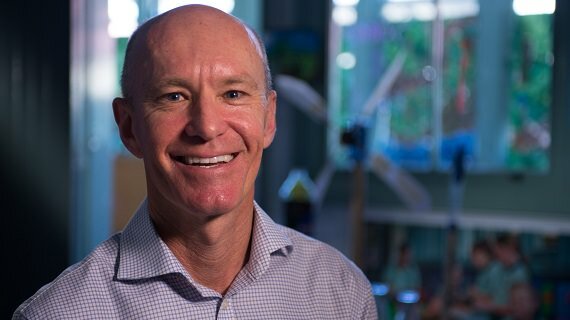Last updated October 23, 2017 at 10:38 am
Neil Bramsen is the recipient of the 2017 Prime Minister’s Prize for Excellence in Science Teaching in Primary Schools for his innovative partnerships with scientists, the community and other schools to foster students’ enthusiasm, knowledge and skills in science.
He sees science as an enabler of learning across the curriculum. “It’s a way of hooking kids into learning. We want kids to enjoy school. It’s got to be a balance of fun and learning.”
 Over the past ten years at Sussex Inlet Public School and Mount Ousley Public School, Neil has renewed science teaching across both schools. He worked with the NSW Science and Maths syllabuses to create opportunities for primary children to work scientifically and technically across multiple content areas.
Over the past ten years at Sussex Inlet Public School and Mount Ousley Public School, Neil has renewed science teaching across both schools. He worked with the NSW Science and Maths syllabuses to create opportunities for primary children to work scientifically and technically across multiple content areas.
When the school kindergarten had an empty sandbox the older students were invited to solve the problem. They developed their own ways of measuring the amount of sand needed to fill it. Three weeks later, with credit card in hand, the students phoned up the supplier and placed the order.
Students also created the school’s butterfly garden themselves. They researched, costed, ordered and constructed the garden where they could watch the life cycle of the Monarch butterfly and use the space for reading and quiet activities.
His school is not far from the beach, so Neil established a marine debris project where students visited the beach and conducted surveys on the debris. He used his CSIRO TeachWild Fellowship to let his students Skype scientists who were conducting research at sea to discuss marine science and the impact of plastic debris on wildlife.
His students have also conducted experiments in space using the Cubes in Space program. They generated a research question, ‘Do magnets work in space?’ and created an experiment within a 16-cm cube to answer the question. The cube was launched into near-space on a NASA sounding rocket and then returned to the students to see how their experiment worked (they found that yes, magnets do work in space).
Neil has taken advantage of every opportunity to develop his skills as an educator. He went to the Honeywell Educators Space Academy in Alabama which led to Neil’s students talking with an astronaut on the International Space Station. He was awarded a Churchill Scholarship to study programs that engage students in maths, engineering, and science in the USA and UK which he then brought to his own school. He also attended the Honeywell Green Boot Camp in San Diego exploring energy, which inspired Neil to get students creating and assessing their own wind turbine blades.
Neil actively shares all that he’s learnt with the wider community of primary school teachers through mentorship within the school, articles for the NSW Science Teachers’ Journal, his extensive personal website, social media (@galaxyinvader), and presenting at conferences and demonstration classes.
He is a dedicated teacher who has developed innovative programs to inspire his students to become the next generation of Australian scientists. It is because of his continuous efforts that Neil is recognised at the Prime Minister’s Prizes for Science.
RELATED VIDEO: 2017 Prime Minister’s Prizes for Science Part 1
Image credit: top: Prime Minister’s Prizes for Science/WildBear, below: supplied by Neil Bramsen
Australia’s Science Channel is proud to be a media partner for the Prime Minister’s Prizes for Science 2017.
Follow us on Facebook, Twitter and Instagram to get all the latest science.
































































































































































































































































